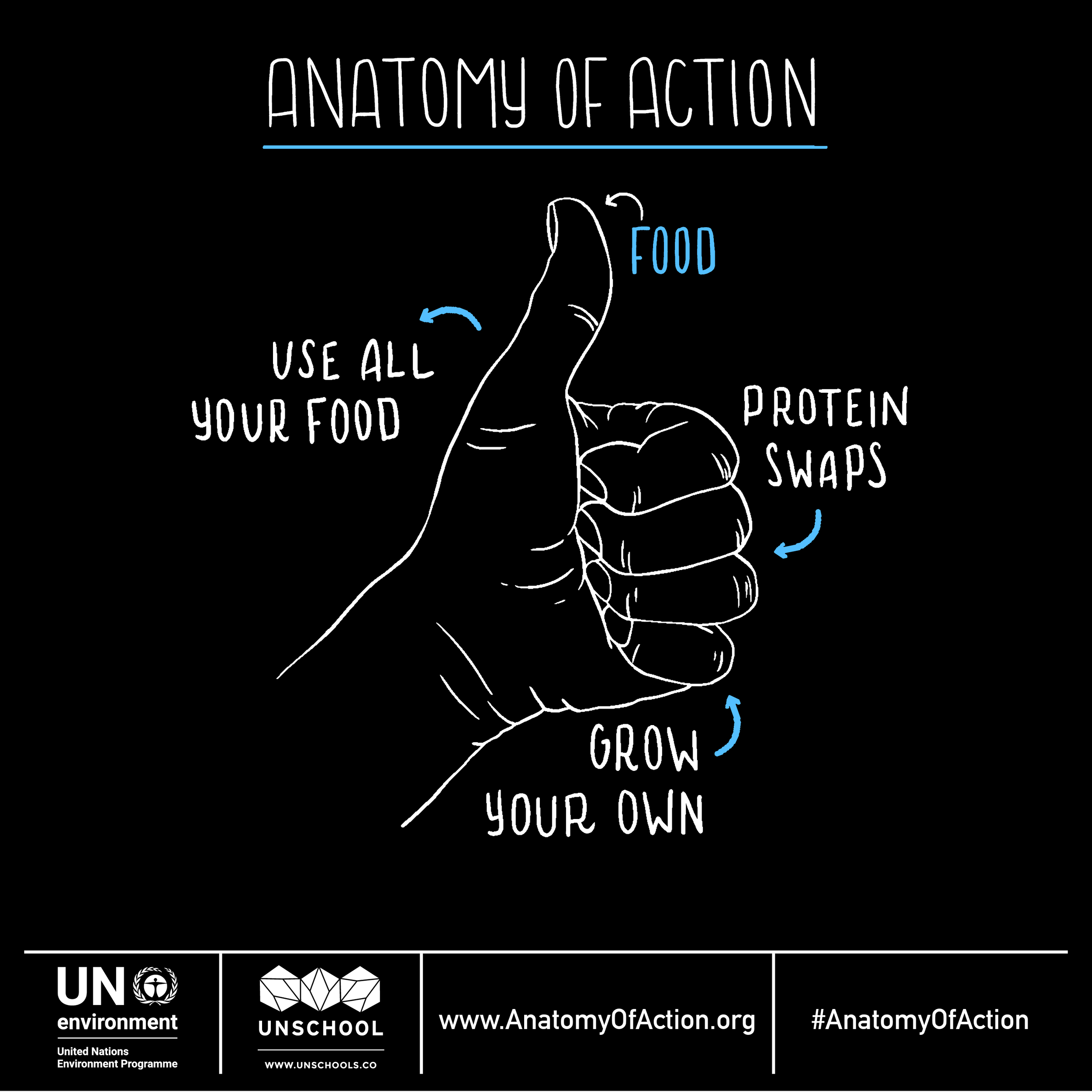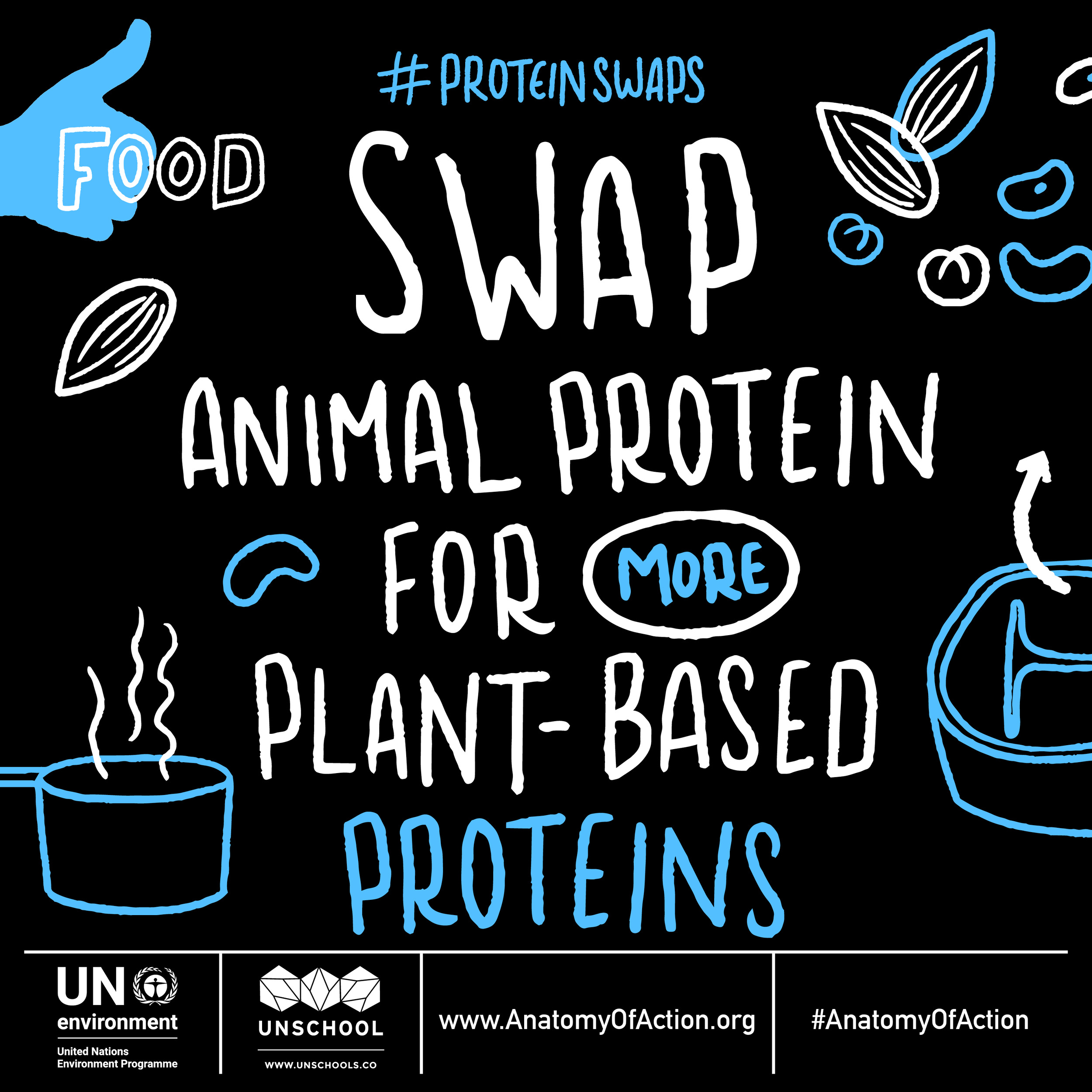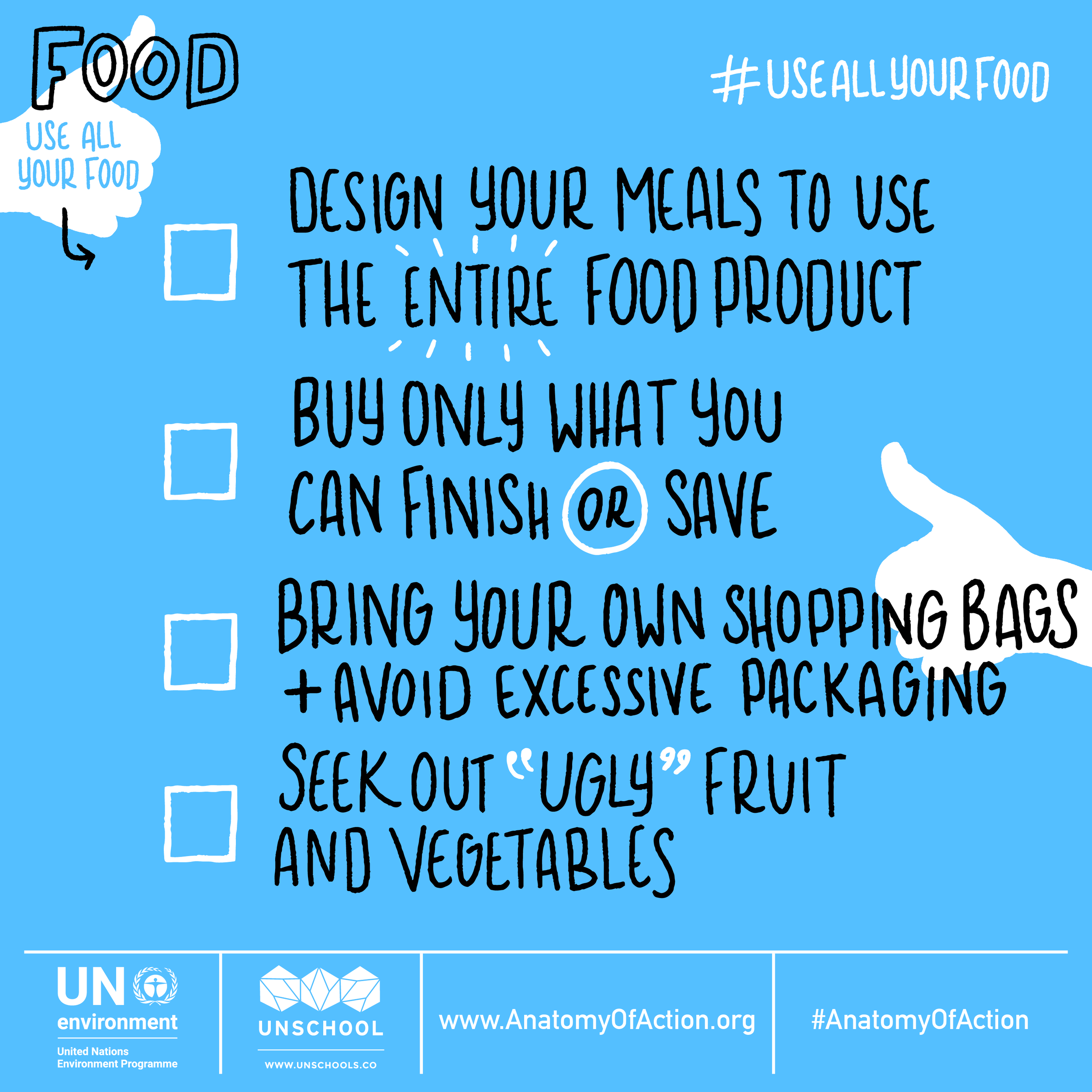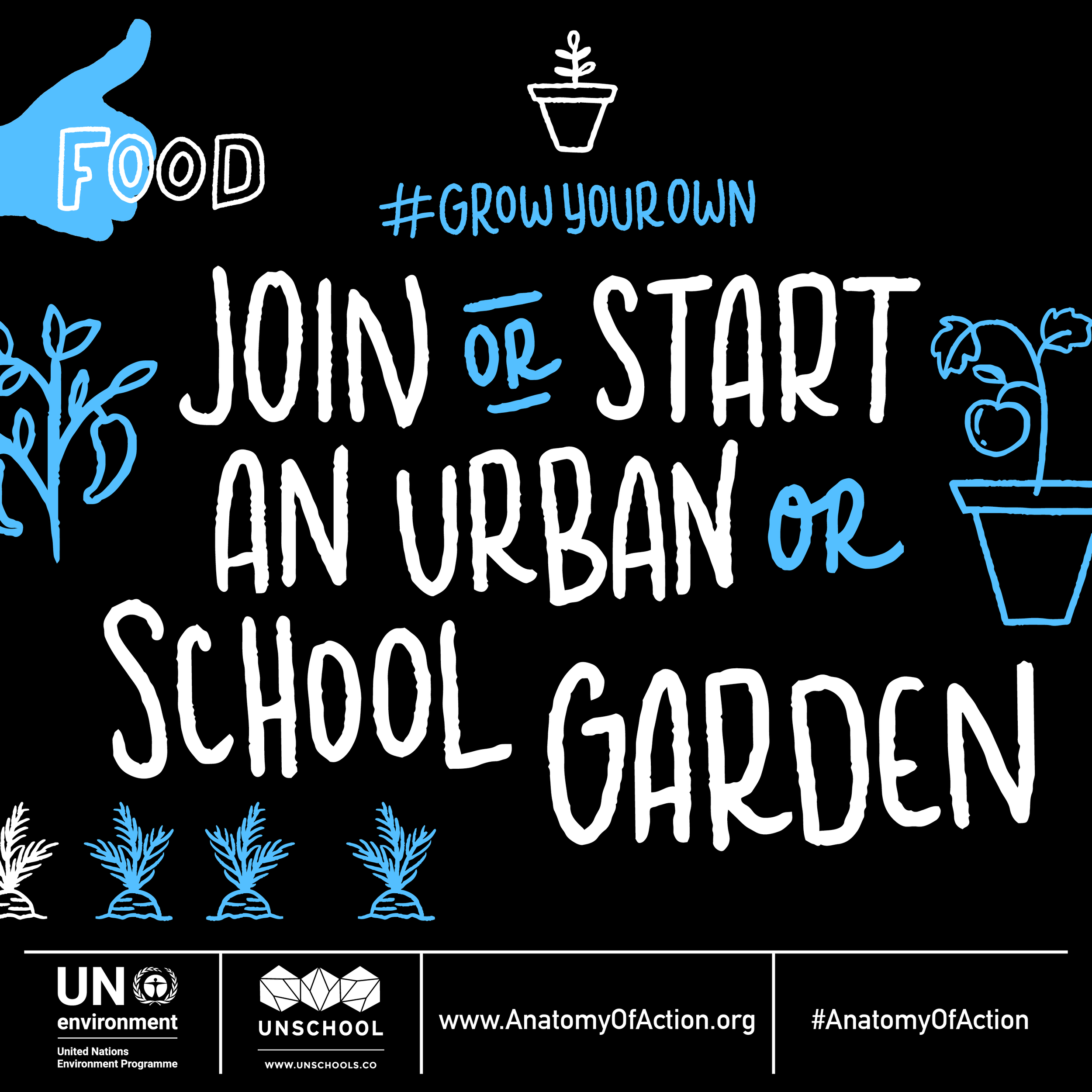Food! Delicious, terrible, gross, amazing — everyone loves it, we all need it, Instagram is filled with it, and it's the biggest impact of our daily lives, which is exactly why we chose it as the first action in our Anatomy of Action (AoA) set. Let’s take a look at the issues and opportunities that we all have with the food in our life, via the three action areas that we set out in the AoA: protein swaps, using all your food, and growing your own. Then pick and action and get started!
ACTION 1: PROTEIN SWAP
If you’re at all into sustainability, then you’ve surely heard that reducing meat consumption — which we have coined as “Protein Swaps” in the AoA to have a more positive, inclusive impact — has a tremendously positive impact on the planet’s health and the well-being of billions of animals and people. But before narrowing down on that, it’s important to point out that the staggering increase in meat production that we have all experienced in our lifetimes is a brand new phenomenon — never before in human history have we humans eaten so much meat. Experts estimate that total meat production has increased 4-5 fold since 1961, and in order to meet the demand, over 70% of the world’s farm animals are now factory farmed (including 99% of the animals in the US!). This massive uptick in meat production is accompanied by a massive uptick in greenhouse gas (GHG) emissions (and a huge freshwater footprint), with livestock and their byproducts accounting for at least 32,564 million tons of CO2e per year, or 51 percent of annual worldwide GHG emissions. Which all makes sense when you discover that every year in the US alone, according to the US Meat Institute 9 billion chickens (yes that’s a B), 32.2 million cattle and calves, 241.7 million turkeys, 2.2 million sheep and lambs, and 121 million hogs are killed for meat consumption (here is a creepy real time kill clock).
Given the astounding snapshot of just how pervasive factory farmed meat is, there are, of course, many health and planet impacts that we are often blind to. Without going too much into the details, mass produced meat-based proteins contribute to desertification, deforestation, and nutrification (as well as the development of oceanic dead zones), all while subjecting factory-confined animals to heaps of animal cruelty issues.
It’s no surprise then that various governments around the world are encouraging citizens to adopt a more plant-based diet. For example, Canada released a new national food guide in 2019 that focused on plant-based eating, whereas the UK and the Chinese lawmakers have made statements about the benefits of reducing meat consumption. Similarly, New Zealand’s 2019 Sustainability Report also urges citizens to begin eating more plants, less meat, as did the popular EAT-Lancet Commission Report released earlier in 2019. The US, one of the worlds biggest meat consumers, is also seeing a change in consumer preferencing, with more people opting for plant-centric eating.
Swapping meat-centric food habits for meals with different protein sources is good for your health and for the environment. In many parts of the world this is already a way of life. The best way to re-shape our global food systems is for people to swap meat to plant based options. By making the switch to a more vegetable-friendly diet and being more selective in where your meat comes from (adopt a flexitarian or reducetarian diet!), you can improve your health, lower GHG emissions and reduce biodiversity loss.
#ProteinSwaps Everyday Actions
Swap animal protein for more plant-based proteins
Diversify your diet and cook more at home
Eat what is seasonally available
Opt for locally-produced foods; seek out local farmers and markets that offer sustainable produce
Talk with your friends and family about healthy and sustainable food options to encourage them to swap their diets too
Become an everyday/weekday vegetarian, vegan, or flexitarian
Try to have a rainbow of vegetables on your plate in every meal
ACTION 2: USE ALL YOUR FOOD
Another enormous problem within our food systems that we examined through the AoA is the issue of prolific food waste — 1.3 billion tons are wasted each year, which is an incredible one-third of all food produced globally for human consumption. This isn’t just an ironic issue in the face of widespread world hunger; it also means that “huge amounts of the resources used in food production are used in vain, and that the greenhouse gas emissions caused by production of food that gets lost or wasted are also emissions in vain." And what about the end-of-life for this wasted food in landfills? Given that on average, the carbon footprint of food wastage is around 500 kg CO2 eq. per capita and per year, there are enormous environmental and fiscal opportunities in reducing food waste. In fact, it’s estimated by the Ellen MacArthur Foundation that the U.K. could save “USD 1.1 billion a year on landfill cost by keeping organic food waste out of landfills—this would also reduce greenhouse gas emissions by 7.4 million tonnes p.a. and could deliver up to 2 GWh worth of electricity and provide much-needed soil restoration and specialty chemicals.” For these reasons and more, the second action area focus of our AoA food exploration is all about using all your food.
Using all your food helps reduce food waste which, in trash heaps and landfills, leads to releases of leachates and methane (which is 30x times more potent than CO2). Food scraps and stale bread are not trash at all! They are filled with the building blocks of life-nutrients, which your body and soil can use (replacing fertilizers and chemicals). So, by getting organics out of open dumps and landfills, we can reduce emissions released into the air and give nutrients back to the soil to produce healthier and tastier plants.
#UseAllYourFood Everyday Actions
Design your meals to use up the entire food product
Buy only what you can finish or save — don’t waste food after all you paid for it. If you throw it away, you are tossing your money in the trash
When buying foods, avoid excessive packaging and take your own produce bags
Seek out "ugly" fruit and vegetables to give them a life in your meal
Manage how you store food to maximize freshness, such as using sealed containers in your fridge and pantry
Get (more) into canning, preserves, and freezing to extend food life
Make stock out of food scraps
Compost your food scraps
Share excess food to help ensure everyone has enough (there are many apps that help with this)
Find out what’s available in your neighborhood and advocate for communal composting and organic waste processing solutions
ACTION 3: GROW YOUR OWN
Of course there are many food options for a healthy person and planet, but our 3rd one for the AoA supports you growing your own food and connecting to where it comes from in order to save money and to reduce transport, packaging, and food waste. While we hear a lot of conversation about plastic water bottles and plastic bags — especially when talking about plastic bans — the lesser known truth is that food’s plastic packaging accounts for nearly 50% of plastic waste (!) as waste is generated along the entire life cycle of food products, from the growing practices through to the supermarket and home wastage.
By growing your own food, even if it only replaces just some of what you would otherwise buy, you can connect better to what you eat and reduce the impacts that occur from the growing, packaging, transport, retail practices and food waste. Producing some of your own food has multiple benefits so even a small amount of home grown produce is a great way to start.
Access to land and time to garden of course varies, so if you can’t grow your own food, consider finding local farmers and support them or join a farmers cooperative. There are many benefits to small scale community agriculture — better food, more nutrients, higher air and soil quality, pollinator plants for bees and inspects, and an enhanced sense of community.
#GrowYourOwn Everyday Actions
Farm, plant, and grow whatever you can, wherever you can
Start or join an urban school or kitchen garden
Connect with your food: find out where your food comes from and how it is produced
Regrow vegetables like leeks, carrots, and beets in your house in a glass of water instead of discarding them
If you can’t grow food yourself, support a local sustainable farmer or shop at farmers markets
Promote, develop, and support initiatives in your building, street, or community that increases your access to food-growing space
FOOD!
There are no simple solutions to complex problems, and the food issues we face are indeed complex. While the global environmental issues are big and sometimes overwhelming, they are the outcomes of many individual actions, and of course the decisions made by governments and industry as well. Food is certainly a vital area for progress and change which can start with us exerting our influence over the demand side of the system.
So, the choices we make as individuals, as workers, and as members of societies have the potential to reinforce undesirable actions or to create the opportunity for new, more sustainable solutions.
The actions outlined in the Anatomy of Action are the top-level actions an individual can do to help support the global shift toward shared good-life goals (check out the AoA action validation report to discover more). No matter who you are, every action you take has an impact.
By taking these more considered lifestyle choices, you can contribute to a global movement for a more sustainable future. There are many other things you can do; this list is by no means an exhaustive account of all the aspects of our lives where we need to tackle to meet the SDGs. But it’s a starter list that any individual, anywhere can take action on to help make a positive future for all of us!
























